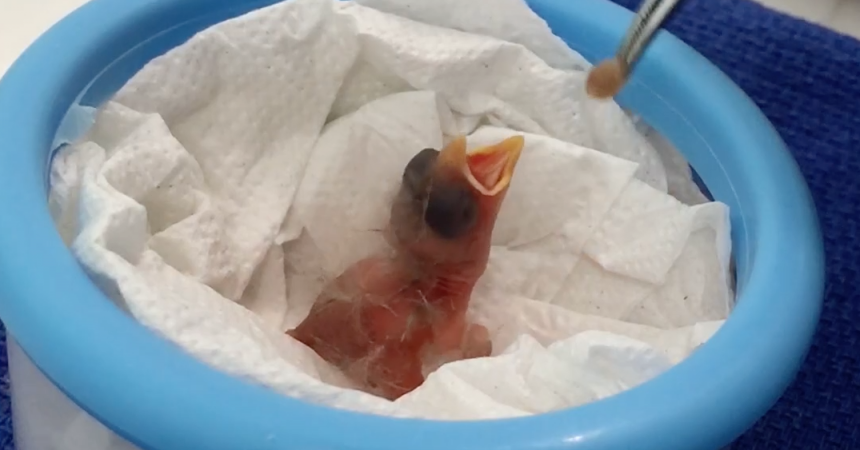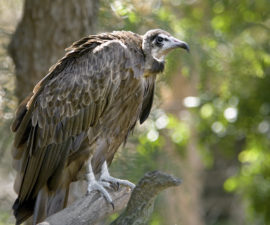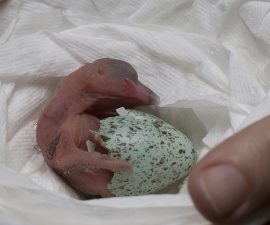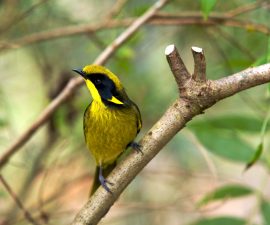A conservation project hand raising the most rare of the “Darwin’s Finches” has entered its third year. In February and March, eggs and nestlings of the critically endangered mangrove finch (Camarhynchus heliobates), one of 15 species of “Darwin’s Finches,” were collected for hand raising as part of the ongoing conservation program. There are thought to be only 80 to 100 mangrove finches left, inhabiting just 30 hectares at two sites on Isabela Island in the Galápagos Archipelago.
The birds are being raised at the Charles Darwin Research Station (CDRS), the operating arm of the Charles Darwin Foundation. The Mangrove Finch Project team, led by the Charles Darwin Foundation and the Ministry of Environment via the Galapagos National Park Directorate (GNPD), collected the eggs and nestlings at Playa Tortuga Negra on Isabela Island from February 6 through March 1, 2016.
“It has been very rewarding to conduct head-starting of the critically endangered mangrove finch for the third season running, working closely with both local and international partners and collaborators,” said Francesca Cunninghame, leader of the Mangrove Finch Project. “Although climatic conditions were dry and fewer pairs were nesting than anticipated, we were still able to collect a good number of eggs and chicks to raise. The adult birds will then re-nest in the wild and also raise their own young. Even better was finally obtaining sightings of two fledglings we had hand-reared in previous years. With this observation, we can be sure that our efforts are producing juveniles capable of surviving in the wild, and our goal of boosting the population of the rarest bird in the Galápagos can most likely be achieved through head-starting.”
In total, 15 eggs and 4 young nestlings were collected from 8 nests and transferred to CDRS. Artificial incubation and hand raising the chicks is led by project collaborators from San Diego Zoo Global. Eggs and chicks are kept in a specially designed room under quarantine conditions, to ensure they do not come into contact with any avian diseases that are not present in the wild mangrove finch population.
“We’re excited to be back in Galápagos working with the Mangrove Finch Project for a third year,” said Beau Parks, lead keeper at San Diego Zoo’s Avian Propagation Center. “It’s incredibly rewarding for our staff to be able to share the experience we’ve gained in our years of raising birds at the San Diego Zoo’s Avian Propagation Center, and to put what we’ve learned to work to prevent the extinction of the mangrove finch.”
The chicks are fed a diet developed at the San Diego Zoo’s Avian Propagation Center for insectivorous passerines and adapted to products available in Galápagos, such as papaya and wasp larvae. For the first 15 days, the chicks are fed every hour from 6 a.m. until 8 p.m. Mangrove finch eggs take 15 days to complete incubation and hatch, and the chicks fledge (leave the nest and fly) 16 to 19 days after hatching. After 8 weeks of successful rearing at CDRS, 15 fledglings will be released to their natural habitat at Playa Negra Tortuga, and scientists and park rangers will monitor them to determine their initial survival.
The weather conditions on Isabela Island in 2016 have been dry with low rainfall, which has contributed to decreased mangrove finch breeding. However, during the recent collection, staff found the first wild-fledged mangrove finch chick to be observed in February in seven seasons. All wild-hatched nestlings during February have a high probability of mortality, due to parasitism by the introduced parasitic fly Philornis downsi. The Mangrove Finch Project team lowered the nest of this chick from the mangroves and removed fly larvae to increase the chick’s chances of survival, then replaced the nest. Mangrove finch nests are found high in the canopy, and rope tree-climbing techniques are required to access them.
For the first time, the Mangrove Finch Project team also observed captive-raised finches from previous seasons in the wild. A banded fledgling that was released in 2014 responded to the recorded call of a woodpecker finch, which was played by a scientist working on a separate project. The other banded fledgling, which was released in 2015, was observed foraging at the forest’s edge. These sightings are positive news for the Mangrove Finch Project—previously, there had been no observations of captive-raised fledglings made after the three-month observation time following their release.
The camouflage coloration of juvenile and non-breeding mangrove finches makes it difficult for researchers to spot them in the wild. The small finch measures about 14cm in height and has dull, brownish upperparts with an olive-brown coloring on its rump. Its breast is off-white with faint dark streaking, the legs are dark and the beak is black.
The Mangrove Finch Project is a bi-institutional project carried out by the Charles Darwin Foundation and Galápagos National Park Directorate, in collaboration with San Diego Zoo Global and Durrell Wildlife Conservation Trust. The project is supported by Galápagos Conservation Trust, The Leona M. and Harry B. Helmsley Charitable Trust, The Swiss Friends of Galápagos and several individual donors. The project team also gives special thanks to the support of Metropolitan Touring, Lindblad Expeditions and Galatour S.A. for transferring Mangrove Finch eggs and chicks, as well as the staff, from northwestern Isabela to Santa Cruz.





